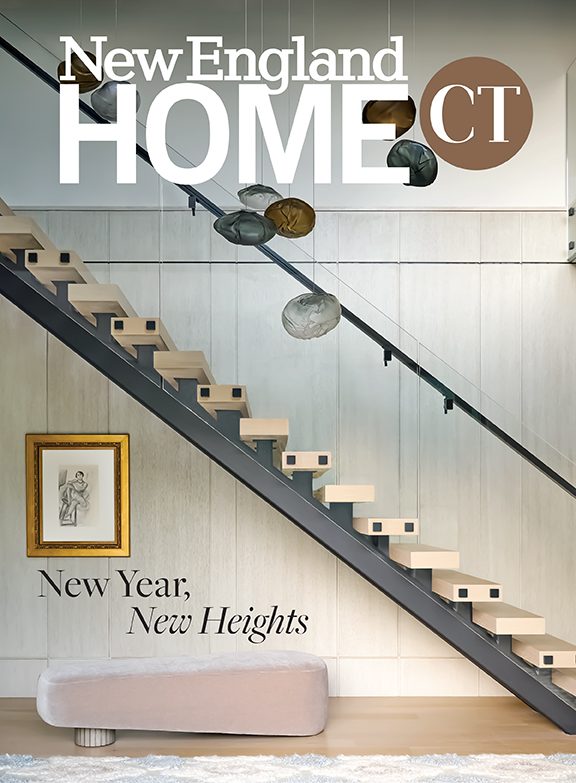Elements of Surprise
May 27, 2010
Text by Louis Postel Photography by Webb Chappell
Click here to see metal artist Mariko Kusumoto demonstrate the intricate workings of her sculpture "Kaiten Zushi."
You’ve just inherited a large house and everything in it. Your designer offers to go through some of the mysterious crates still in the attic. An hour later you’re up there with her, totally amazed. Her flashlight beam rests on a priceless Rodin bronze, a man and woman improbably lifelike there in the musty penumbra of forgotten things.
Then imagine this: your designer suggests leaving it there, half in the box. The normal thing to do (besides auctioning it off) would be to drag it downstairs and put it in a “pride of place” position, at the end of a hall, say, or above the mantel. It’s a great treasure. It begs to be seen. Why leave it as some kind of surprise for occasional attic explorers?
Mariko Kusumoto’s metal sculptures are all about these surprises. For $50,000, give or take, you can display a Kusumoto sculpture in a “pride of place” position, but don’t count on that instantaneous “wow” moment you’d expect from visitors reverently approaching The Kiss. The “wow” moments in Kusumoto’s work—and there are many of them—come slowly, one a time, as you discover them. In a giggly rhythm, one dreamlike sleight-of-hand after another crystallizes. Brass, nickel, silver, sterling, decals, coral, mop fiber glowing psychedelically within pillows of glass resin—all are at the alchemist’s disposal. There’s so much to see and do, the experience provokes even the most jaded visitors to gasp and cry out, “This is too much! How did anyone figure out how to do that!”
Who would be patient enough, skilled enough, strong enough—who would be outrageous enough—to fashion a tiny horned beetle and an equally tiny seahorse drinking themselves into a stupor over a Lilliputian bottle of sake? And who would take even this to the next level by hiding the beetle and seahorse inside a delicately hinged metal piece of salmon sushi? As these little dramas play out, you would not be alone in your wonderment.
“For us, seeing the work for the first time was a magical experience,” says Libby Cooper, co-owner of the Cambridge, Massachusetts, gallery Mobilia, where Kusumoto shows her work fairly exclusively. “Family and friends keep coming back to visit the work, to interact with it. Architects and designers are usually awed by the craftsmanship.”
Born into a priestly family and raised in a 400-year-old Buddhist temple in southern Japan, Kusumoto developed an affinity for metal early on. It was her household task to polish all the religious ornaments. The family was hardly poor, but her mother didn’t believe in toys for children. “I learned to make things up on my own,” she recalls. “I played with the stag beetles, the rocks. I remember using the gravestones as some sort of work table or cutting board.”
Her artistic talent showed early on. “I won all the drawing contests in school,” she says. “I couldn’t wait to leave for Tokyo to art college. I didn’t like having to say all the Buddhist prayers every night.” In Tokyo, she studied painting, but, she says, “It was a course in engraving that got me going. I’ve been working in metal ever since.”
She met her American-born husband in the San Francisco Bay Area. “But I missed the changing seasons. And my dealer, Mobilia, was in the East. So we moved here with our daughter,” she says.
“Here” is a house and studio in an optimistic, mid-century neighborhood in Lexington, Massachusetts. The sound of waterfalls nearly drowns out her voice. She herself is a bit of surprise. How can someone of less than Herculean stature possess such strength, such will to cut and solder and bend all this stuff?
Today is something of a rare day. She has a lot of her work in her house, loaned back by its owners in preparation for a show Libby Cooper arranged at the Fuller Craft Museum in Brockton, Massachusetts. (Her work sells too quickly and is too expensive for the couple to keep for themselves).
A single piece, such as her thirteen-inch-tall, two-story, sushi restaurant, takes three or four months of full-time labor. “I start off with Photoshop imaging software, along with paper models,” Kusumoto explains. “Once I start, I don’t stop. I don’t believe in doing things half-way.”
The emphasis she places on this last sentence leaves no room for doubt. She may be crafting an unfolding man-shirt for her multi-level Bloomingdale’s store, or a tiny brooch in bronze, brass, sterling, nickel and silver—whatever it is, there’s a measured power to all this phantasmagoria.
There is also, however, a downside to her virtuoso precision and patience. These are qualities one ordinarily associates with a fine jeweler or metalsmith, not the heroic, big-gesture, splatter-painting idea of artist we’ve come to know in the modern era. For this reason, Kusumoto finds herself in what her husband refers to as “an arts backwater—which comes under the heading of crafts.”
But make no mistake: Kusumoto’s precision-made unfolding boxes and purse-teapots and department stores are as High Art as any iconoclastic plate-smashing. What some might mistakenly relegate to a “crafts backwater” is actually a space representing a very different, exceedingly refined culture. Kusumoto’s art may masquerade as a series of visual puns or a simple exercise in virtuosity, but there’s a lot more to be found under the etched skin of those coppers and bronzes. There you will find the DNA strands of a highly refined Japanese Buddhist culture; a culture Kusumoto inherited almost as birthright. As much as she resented the mandatory prayers, the Buddhist concept of constant change is something very much with her. The surprises she so cleverly builds into her sculpture speak volumes for the transitory nature of all life. Every moment is unique and unlike the rest.
Robin Williams may not be a practicing Buddhist, but the fact that his emotions are so playful and fluid makes him one of the most watchable of movie actors. It’s no accident that he’s one of Kusumoto’s key collectors. You can imagine how he would experience some of the pieces temporarily displayed in Kusumoto’s living room. You can picture his expressions of delight, dismay, curiosity, even a kind of soulful compassion for the poor Geisha in the freak-show tent. He removes an etched metal plate and finds her skeleton. Under that layer, he finds unborn children. He leaps to the next table where he finds Kusumoto’s multi-storied game tower, Ryounkaku, inspired by Tokyo’s first Western-style skyscraper (“complete with elevator” adds Kusumoto). The original Ryounkaku famously collapsed in the earthquake of 1923. Every panel of the Ryounkaku opens to a miniaturized human drama. Robin Williams would be transfixed. Finally he would throw the single, engraved die. Oh no! He’s landed in the Meditation Room high in the Tower. According to Kusumoto’s rules, Williams would be forced to miss a turn!
Why are we not surprised?
Editor’s note: Click here to see metal artist Mariko Kusumoto demonstrate the intricate workings of her sculpture "Kaiten Zushi." Mariko Kusumoto is represented by Mobilia, Cambridge, Mass., (617) 876-2109, www.mobilia-gallery.com. Her show Unfolding Stories runs from May 22–August 8 at the Fuller Craft Museum, Brockton, Mass., (508) 588-6000, www.fullercraft.org.
Share
![NEH-Logo_Black[1] NEH-Logo_Black[1]](https://b2915716.smushcdn.com/2915716/wp-content/uploads/2022/08/NEH-Logo_Black1-300x162.jpg?lossy=1&strip=1&webp=1)
























You must be logged in to post a comment.